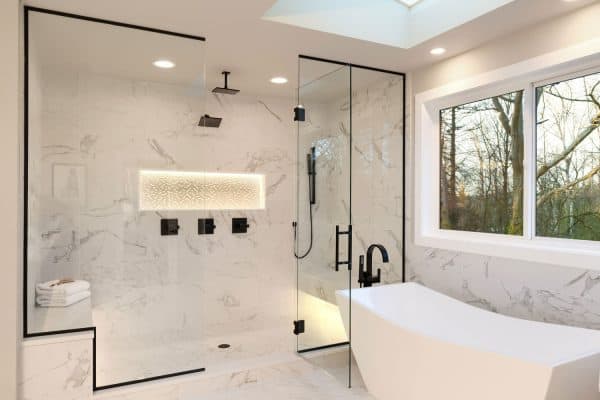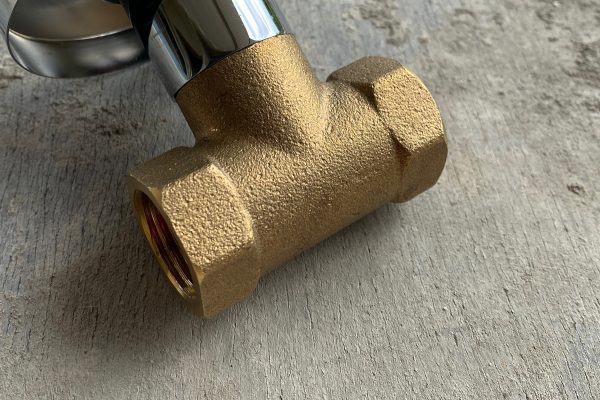If you're looking for a new bathtub, you might be overwhelmed by the number of choices. Shape, size, cost, and material are just some of the options on the market. One popular option is an acrylic tub. Like all materials, acrylic tubs have both positive and negative aspects that should be considered. We've done the research to bring you a comprehensive look into these attributes so that you can make an informed decision.
Acrylic bathtubs have some positive and negative aspects. They are as follows:
Advantages:
- Affordable
- Retain heat
- Come in a variety of colors and shapes
- Lightweight
Disadvantages:
- Easier to scratch
- Stain easily
- Feel cheap
- May be damaged by some cleaning products
An acrylic bathtub might not be right for everyone and every situation. In this guide, we'll take a closer look at all the characteristics of acrylic bathtubs, what cleaners are suitable for them, what their lifespan is, and more. So be sure to keep reading.

Advantages Of Acrylic Bathtubs
Affordable
Acrylic is one of the most affordable materials for bathtubs. The average price for an acrylic tub is between $500-$1,000. The material that is often cheaper, fiberglass, is more porous and doesn't resist water as well.
In fact, acrylic bathtubs generally come reinforced with fiberglass. The acrylic material is vacuum-sealed over layers of fiberglass. This gives the tub the water-resistant properties of acrylic with the strength and rigidity of fiberglass. All of that comes at a more affordable price than ceramic, porcelain, or cast iron.
Retains Heat
Nobody wants to take a bath in water that becomes tepid after a few minutes! Acrylic tubs are non-porous, meaning all the elements of hot water remain.
Additionally, because acrylic is not a type of metal or hardened clay, it stays warm to the touch even without hot water. This makes it much more comfortable in every situation.
Comes In A Variety Of Colors And Shapes
Acrylic is easier to mold than other materials and is significantly cheaper to produce. Thus, you can find acrylic tubs in many different shapes and sizes.
A standard rectangle that will fit into most structured bathtub slots is a common choice.
We may include affiliate links and curated AI content to highlight top design styles.
Click here to see this acrylic bathtub on Amazon.
You can also find unique shapes of acrylic tubs such as the ones below.
If you're looking for a classy, stand-alone option, you might be interested in these products. Make sure they fit in your bathroom and that you have the appropriate water hookups.
Woodbridge Freestanding Tub
Click here to see this acrylic bathtub on Amazon.
Woodbridge Contemporary Tub
Click here to see this acrylic bathtub on Amazon.
This tub is designed with one end higher than the other for additional comfort.
Click here to see this acrylic bathtub on Amazon.
Lightweight
Acrylic bathtubs are easier to install than other heavier materials. The typical acrylic tub weighs approximately 60 pounds, while a cast iron tub can weigh up to 300 pounds.
This makes them easier to install, but also provides long-term relief for your bathroom floor and joists. Floors that have to hold great weight for years often sink, separating from walls and causing expensive damage.
Disadvantages Of Acrylic Bathtubs
Easier To Scratch
Acrylic is a soft material, which is what makes it light and moldable. However, this means that the surface scratches easily. Any material that is harder than acrylic will dig into the tub and leave a scratch. Unlike some other materials, though, acrylic is simple and easy to repair.
Stains Easily
Again, acrylic tubs are less durable than other types of tubs such as cast iron. After five to ten years, acrylic tubs will show signs of rust, human dirt, or soap stains.
This is especially difficult because many of the products that are designed to remove stains are too harsh for an acrylic tub, and thus cannot be used.
Feels Cheap
Because acrylic tubs are more affordable than other types of tubs, they are less sturdy. Often, residents describe them as feeling and sounding hollow. Even though they are supported by fiberglass, they are not as heavy as cast iron, porcelain, or ceramic.
In fact, if you push on the side of an acrylic tub, you will notice the "give" of the material as it pops in. You might also notice that dents occur when the acrylic tub takes on too much pressure for an extended period of time.
Damaged By Some Cleaning Products
Some cleaning products are too abrasive for acrylic tubs and will scratch or damage them. You must be careful with the ingredients in a normal bathroom cleaner before applying it to an acrylic tub. Otherwise, there will be little spots left all over the tub where the acrylic has worn down.
What Cleaning Products Are Safe On Acrylic Bathtubs?
When cleaning your acrylic bathtub, a simple solution of water and vinegar can remove soap scum and other dirt. Dilute the vinegar with water at a one-to-one ratio and put it in a spray bottle.
Or, simply use dish soap with a soft rag and hot water. This is tough enough to eliminate grease and dirt, but gentle enough to avoid damaging the tub.
If you choose to purchase a product, make sure it is labeled "non-abrasive." You should also avoid aerosol products, as the aerosol chemicals are harsh and damaging. Whenever you use a cleaner, make sure to rinse it with warm water immediately after you finish cleaning.
One excellent example of a non-abrasive, non-aerosol product is a Scrub Free total bathroom cleaner. It is specially formulated to work safely on acrylic bathtubs.
Click here to see this cleaner on Amazon.
What Is The Lifespan Of An Acrylic Tub?
An acrylic bathtub will typically last ten to fifteen years. This is considered a good lifespan for the cost of the tub and the installation. After this time, noticeable wear will show stains, scratches, and other marks. When a scratch appears, fix it quickly so that it can't grow and so that water can't leak underneath the acrylic cover.
The good news is, however, that acrylic tubs are less likely to crack over time than other types of tubs. Essentially, the only reason you'll want to replace the tub after ten or fifteen years is for cosmetic purposes.
If you're looking to replace your bathtub, check out How Much Does It Cost To Replace A Bathtub?
Is An Acrylic Bathtub Toxic?
Acrylic bathtubs are not toxic. Though acrylic is technically plastic, it emits no fumes, gases, or toxins. Compared to other types of plastics, acrylic is incredibly safe for your home.
How Can You Tell If Your Bathtub Is Acrylic Or Fiberglass?
Fiberglass and acrylic are similar materials that are each made out of a type of plastic. Unfortunately, if you were not the one to purchase the tub, it is difficult to tell which it is. There are a couple of clues, however.
If your tub shows signs of cracking or chipping, it is probably fiberglass. Fiberglass is not as non-porous as acrylic, meaning it lets in tiny amounts of water that cause cracks.
Similarly, fiberglass will chip if you drop something heavy on it. Acrylic, on the other hand, will scratch instead of chip. If your tub has numerous scratches, it is probably acrylic.
Looking for a comparison between acrylic and fiberglass? Check out Is An Acrylic Shower Better Than Fiberglass? for more information!
In Closing
In addition to their low prices, acrylic tubs are lightweight, come in whatever shape you'd like, and are comfortable to use. They are quicker to scratch and fade, are tougher to clean, and do not feel as sturdy as other materials. Thus, if you are looking for an affordable bathtub and are willing to sacrifice some durability and lifespan, you should consider an acrylic tub.
Happy bathing!





![Marble walled shower wall, 5 Best Types Of Shower Wall Panels To Consider For Your Bathroom Renovation [The Ultimate Guide]](https://homedecorbliss.com/wp-content/uploads/2023/07/shutterstock_2138160219-600x400.jpg)

